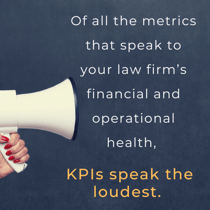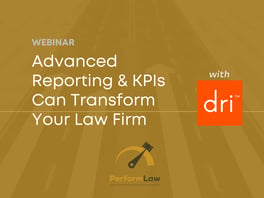What are KPIs? And how can they guide the success and improvement of your law firm?
Of all the metrics that speak to your law firm’s financial and operational health, KPIs speak the loudest. Even if your firm does not currently have an advance reporting system in place, you can start now by incorporating the suggestions and new-and-improved KPI metrics outlined below. In doing so, you will be able to reshape how you view productivity and efficiency at your law firm.

![]() 1. Get More Accurate.
1. Get More Accurate.
With recent hikes in turnover and hiring struggles across the country, you might be thinking about your staffing headcount more frequently. But headcount may not be very informative at the end of the year when you know you had 35 attorneys pass through your doors but only about 20 of them were there at any given time. Instead of headcount, we recommend Full-Time-Equivalency, or FTEs, for their higher accuracy.
FTEs are a proportion of a time period. E.g., If an employee was present half the year, the FTE is 0.5 years. For example, you might have had a total of 30 attorneys this year but due to turnover, only 23.7 in FTEs. FTEs are a better representation of your firm’s revenue-producing capacity because they take into account not only how many people you have, but how much time they spent at your firm as well.
You can also use FTEs to help you scale your metrics down to a per-person level to make them easier to understand and more effective. For example, we recommend calculating KPIs like Billable Hours Per FTE and Overhead Per FTE.
![]()
- Make Comparisons in Proportion to Your Firm.
Expenses don’t exist in a vacuum. They exist in the context of firm size and productivity. How can you tell if you are spending too much when budgets look different for every firm? Try to get some perspective using percentages.
For example, the next time you want to tell if an attorney’s salary is fair, don’t just look at annual salary plus bonus. Divide their payroll by billings and/or collections to take into account their productivity. Typically, 30-35% of collections is healthy, but there are exceptions, such as for rainmakers.
You can also analyze other expenses in this fashion – for example, “Office Expenses as a % of Fees Billed” or “Benefits as a Percent of Payroll,” but keep in mind that the benchmarks differ from metric to metric.
![]()
- Operational, Not Just Financial.
Are you looking at the same three tired old stats over and over again? For example, billed hours, rates, and collections? Step up your game using operational KPIs. These will help you better understand your employee productivity, firm’s procedural efficiency, employee satisfaction, client satisfaction, firm’s ability to attract clients, and much more.
|
BASIC |
INTERMEDIATE |
ADVANCED |
|
Case count |
Number of days the average file is open |
Assignments/tasks completed per timekeeper |
|
Open cases vs. closed cases |
Number/rate of files opened and closed |
Staffing efficiency (over- vs under-utilized employees) |
Not sure where to begin? Check out our starter list:
One of the most difficult parts of developing a business approach driven by data is deciding what to measure in the first place. This KPI starter list is a great place to begin:
|
CATEGORY |
KPIs |
WHAT'S IT GOOD FOR? |
|
|
Headcount |
Track how well you fuel your revenue machine |
|
Billable Hours Per FTE |
Measure attorney productivity |
|
|
|
Payroll % of Collections |
Puts costs into perspective |
|
|
Total Overhead Per FTE |
|
|
|
Profit % of Collections |
Puts profit into perspective |
|
|
Average days files are open |
Understand case handling efficiency |
|
Average time spent on a case |
||
|
Utilization rate (billable vs non-billable hours per timekeeper) |
Watch out for employee burnout and turnover |
|
|
Timekeeper % of time spent in overutilized, healthy and underutilized state |
||
|
Workplace Satisfaction |
||
|
Turnover Rate per year |
||
|
|
New/active clients versus lost clients |
Track and compare firm workload and revenue stability across time periods.
|
|
Client retention rate |
ADDITIONAL RESOURCES
WATCH: WEBINAR: Advanced Reporting & KPIs Can Transform Your Law Firm

READ: Financial and Operational KPIs Your Law Firm Can Track Right Now
 Use the space below to subscribe to our blog so you don't miss great tips and information to help you build a great law firm.
Use the space below to subscribe to our blog so you don't miss great tips and information to help you build a great law firm.
.webp?width=124&height=108&name=PerformLaw_Logo_Experts3%20(1).webp)

